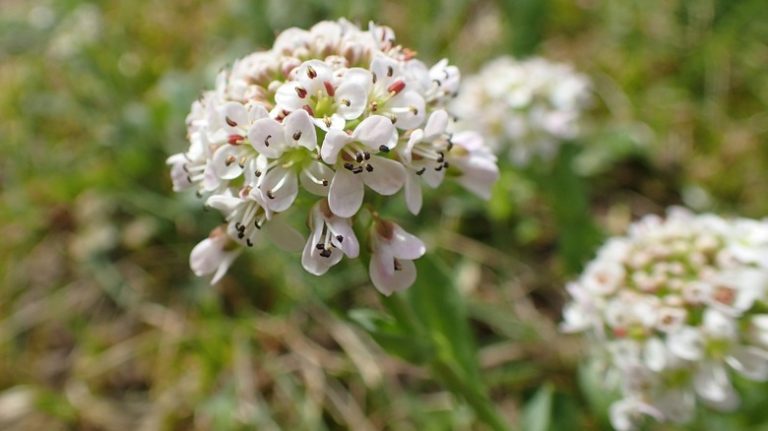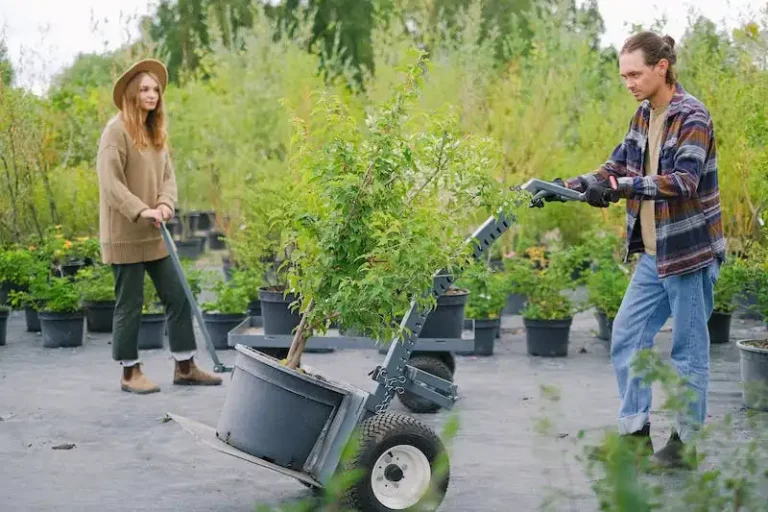Hyacinth and Muscari, also known as grape hyacinth or squill, are two popular bulb plants that bring color and fragrance to any garden or container. With their vibrant petals and sweet scents, these spring-blooming perennials have been cherished for years by gardeners and horticulturists alike.
Hyacinth, particularly the ‘Carnegie’ variety, is a well-loved bulb that produces large, bell-shaped flowers in a variety of colors. These flowers are characterized by their streaked or broken petals. Hyacinths tend to multiply quickly and can be grown both outdoors and in containers.
Muscari, on the other hand, often referred to as grape hyacinth or squill, is a smaller bulb plant that produces clusters of tiny, bell-shaped flowers. These flowers can be blue, purple, white, or even yellow in color. Muscari bulbs are hardy and can survive harsh winters, making them ideal for gardeners in cooler climates.
When it comes to caring for hyacinth and Muscari bulbs, there are a few important things to be aware of. These plants prefer sunny locations with well-drained soil. They need a period of cold in order to bloom, so they should be planted in the fall. Hyacinth and Muscari bulbs should be planted with their pointed ends facing up, about 4-6 inches deep, and spaced evenly apart.
After planting, these bulbs should be watered thoroughly and then left alone during the winter months. Once spring arrives, the bulbs will burst into flowering, welcoming the new season with their vibrant colors and fragrant blooms. It’s important to keep in mind that hyacinths and Muscari tend to be companion plants, meaning they grow well together and make a beautiful pair when planted side-by-side.
It’s also worth noting that hyacinth and Muscari bulbs can benefit from a feeding of bone meal or a balanced fertilizer in the spring, while the plants are actively growing. Removing the spent blooms and leaves after flowering will help prevent the bulbs from wasting energy on seed production and encourage healthy growth for the following year.
Overall, hyacinth and Muscari are easy to grow and care for, making them a popular choice for both experienced and novice gardeners. With proper care and attention, these spring-blooming bulbs will bring years of joy and beauty to your garden.
“Hyacinths and Muscari are like little bursts of spring, providing a welcome burst of color and fragrance after the long, cold winter months.” – Peter, Gardening Expert
Whether you choose to plant hyacinths and Muscari in the ground or in containers, these bulbs are sure to add a touch of magic to any garden or space. Their vibrant colors and delightful scents make them the perfect choice for any garden enthusiast.
Source: www.gardeningarticles.com
How to Plant, Grow, and Care for Hyacinth
Hyacinth is a popular flowering bulb that is known for its pointed blooms and delightful fragrance. It is easy to grow, and the care it requires depends on the growing conditions and the climate in which it is grown. Whether you’re an experienced gardener or a beginner, this article will help you understand how to plant, grow, and care for hyacinth.
Planting Hyacinth
Hyacinth bulbs should be planted in loose, well-draining soil. The depth and spacing of the bulbs depend on the size of the bulbs and the desired effect. As a general rule, plant the bulbs about 4-6 inches deep and space them about 4-6 inches apart. If you’re planting them in a container, make sure it has drainage holes and use a good quality potting mix.
Hyacinth bulbs can be planted outdoors in the fall, before the first frost. They can also be grown indoors in a cool room and then moved outdoors once the danger of frost has passed.
Growing and Care
Hyacinths grow best in a sunny location with well-draining soil. They prefer cool temperatures and can tolerate mild frost. In colder climates, they can be grown as annuals or lifted and stored over the winter in a cool, dark place. In warmer climates, they may not bloom again unless the bulbs are cooled in the refrigerator for several weeks.
To encourage better flowering, fertilize the plants in early spring with a slow-release fertilizer. Water regularly, but be aware that hyacinths don’t like to be overwatered. It’s also a good idea to remove the spent flowers to prevent the plant from putting energy into seed production.
Hyacinths are generally pest-free, but they can be susceptible to bulb rot or pests such as aphids and slugs. If you notice any issues, treat them accordingly.
Propagation
Hyacinths can be propagated by bulb division or from seed. Bulb division is the most common method, as it allows you to get bigger, flowering plants faster. Wait until the foliage has died back before dividing the bulbs. Separate the larger bulbs from the smaller ones and plant them separately.
If you choose to grow hyacinths from seed, collect the seeds from the dried seed capsules once they have turned yellow. Sow the seeds in pots or trays filled with well-draining soil. Keep the soil moist and place the pots or trays in a cool location. The seeds will germinate in a few weeks, and the young plants can be transplanted once they have developed a few sets of leaves.
Pruning and Maintenance
After the flowers have faded, allow the foliage to die back naturally. This allows the plant to store energy for the next year’s growth. You can remove the foliage once it has turned brown and crispy. Some gardeners prefer to tie the foliage into a loose knot or braid to keep it tidy.
Hyacinths can be prone to ‘flower jacket’ or botrytis, a fungal disease that can cause flowers to turn brown and petals to become streaked. To prevent this, make sure the plants are well-spaced and have good air circulation. Avoid overwatering and remove any infected flowers or foliage.
Conclusion
Hyacinths are a beautiful addition to any garden or indoor space. With their vibrant colors and fragrant blooms, they are sure to brighten up any front yard or living room. Whether you’re a seasoned gardener or a novice, this article has provided you with the essential information to successfully plant, grow, and care for hyacinth plants. If you have any further questions, don’t hesitate to ask your local garden center or reach out to our editorial team for assistance.
Hyacinth Meaning
The hyacinth is a beautiful flowering plant that is known for its vibrant colors and fragrant blooms. It is a symbol of rebirth and the arrival of spring, making it a popular choice for gardens and floral arrangements. The name “hyacinth” comes from the Greek word “hyakinthos,” which means “flower of a Greek god.” It is said that the hyacinth was created from the blood of the Greek god Hyacinthus, who was accidentally killed by the god Apollo.
Hyacinths are bulbous plants that are easy to grow and require little maintenance. They prefer a cool climate and are often planted in the fall or early winter. They can be planted in containers or directly in the ground, and they are known to naturalize and continue to bloom for many years. The bulbs should be planted about three times the height of the bulb deep in well-draining soil.
Hyacinths come in a variety of colors, including shades of blue, purple, pink, white, and yellow. Some varieties have a spotted or streaked appearance. They have a sweet and pleasant fragrance that fills the air when they are in bloom.
One of the benefits of planting hyacinths is that they tend to deter pests such as aphids and other insects. Their toxic bulbs and leaves are unappetizing to these pests, making them less likely to infest the surrounding plants.
Hyacinths are also a companion plant to grape vines. The bulbs produce a substance called grape hyacinthin, which helps to improve the growth of grapes. This makes them a welcome addition to vineyards and gardens.
Hyacinths are often forced to bloom indoors during the winter months. This is done by pre-chilling the bulbs in the refrigerator for a period of time, and then placing them in a pot or container with enough soil to cover the bulbs. With the right care and temperature conditions, the bulbs will burst forth with beautiful blooms.
If you are a gardener who wants to continue growing hyacinths year after year, you can try propagating the bulbs. This can be done by carefully removing the offsets or shoots from the parent bulb and planting them in a separate location. Be sure to wait until the shoots have cooled and dried, as this will help reduce the risk of rot and other problems.
In conclusion, the hyacinth is a versatile and beautiful plant that brings color and fragrance to gardens and homes. Whether you appreciate its symbolism, its beauty, or its role as a companion plant, the hyacinth is a great addition to any collection of spring-blooming flowers.
Source: Example Article
Hyacinth Care
Hyacinths are excellent spring-blooming flowers that come in a wide range of colors, including purple-blue, white, pink, and yellow. They are generally planted in the fall and require a period of cold dormancy in order to bloom successfully. If you live in a colder climate, this may not be an issue as the winter temperatures will provide the necessary chilling period. However, if you live in a milder climate, you may need to chill your hyacinth bulbs in the refrigerator for about 6 to 8 weeks before planting them.
Hyacinths grow best in well-drained soil and should be planted in a sunny to partially shady location. They prefer indirect sunlight and can tolerate some shade, especially in hotter climates. Hyacinths also thrive in damp conditions and will enjoy an occasional misting to increase humidity.
When planting hyacinth bulbs, make sure to select a location with enough space for them to grow. Hyacinths are usually planted in groups or rows, with the bulbs spaced about 6 inches apart. The planting depth should be about 4 to 6 inches, with the pointed end facing upward. After planting, water the bulbs thoroughly and then cover them with a layer of mulch to help insulate them during the colder months.
Hyacinths require minimal care once they are planted. Water them regularly, especially during dry periods, and fertilize them with a balanced fertilizer in the spring and fall. Be sure to remove any dead or broken leaves to prevent the spread of disease and to keep the plants looking their best.
During the blooming season, hyacinths are known for their bell-shaped flowers that have a strong fragrance. The flowers typically last for several weeks, depending on the variety. Once the blooms have faded, you can deadhead them by removing the flower stalks. This will help focus the plant’s energy on producing new blooms.
Hyacinths make excellent companion plants and can be planted with other spring-blooming bulbs such as daffodils and tulips. They also look stunning when planted in large groups or as borders along sidewalks or lawns. Hyacinths are frequently used in flower arrangements and can provide a burst of color and fragrance to any home.
In summary, hyacinths are beautiful spring-blooming flowers that require a period of cold dormancy to bloom successfully. They prefer well-drained soil, indirect sunlight, and regular watering. With proper care and attention, hyacinths will reward you with their stunning blooms and delightful fragrance.

